|
|
|
| |
Ibike
Korea People-to-People Program
|
| |
|
| |
|
| |
|
 Photo essay: Hwacheon
to Pallang-ri Photo essay: Hwacheon
to Pallang-ri
|
| |
|
(50mi, 80km) Beautiful valleys separated by mountain passes (3).
Points of Interest: Peace Dam, Bangsan Kiln, Jikyeon Falls, battle fields,
northern defenses, Pallang-ri Folk Museum |
| |
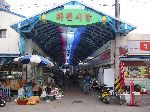
|
Overnight the market has been
cleaned. The first vendors return and start setting up before 7 a.m. but
the market won't be crowded for a couple more hours. |
| |
|
The hardware store has a wide variety
of goods in a small space; tools, paint, chain, fasteners, brooms, containers,
fencing, etc. |
| |
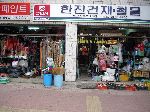 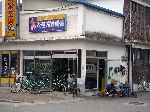
|
If such a thing exists,
this is a pretty typical bike shop; doors wide open, some of the inventory spilling
out on to the street and repairs being done right inside the front door.
Sometimes repairs are done out on the sidewalk as well.
|
| |
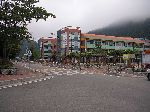
|
Pedestrian and bicycle facilities as they approach the
elementary school. Pedestrian movements
are controlled by fencing. There is a speed-bump to slow motor vehicles.
Yellow textured pavers are used to assist the sight-impaired. |
| |
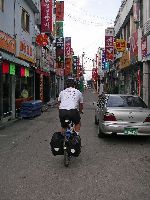
|
Narrow street of the business
district of Gapyeong. The roads are still quiet when we head out of town. |
| |
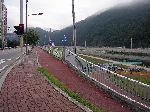
|
The river by Gapyeong has non-motorized
trail facilities both at street level and near the river
side. It is typical for river banks to be used for trails in and near the
towns and cities around the country. The facilities near the river are generally in
the flood plain so might not be accessible at all times. |
| |
 |
This is the historic
Hwacheon Kkeomeok Bridge -- fortunately there is no test at the end. Built
in 1945, so it survived the war and probably a few floods. The sign says
it is Korea's longest steel-frame and concrete bridge and a location for the
movie War Comrade. |
| |
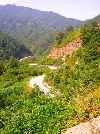 |
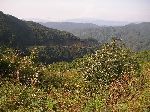 A major feature of the day is climb
ridges and descending down the other side. They aren't steep but they take
perseverance. They curve so much that you can really tell how high you
climb. It is probably just as well because if you could see the top from
the bottom you would probably be totally demoralized. A major feature of the day is climb
ridges and descending down the other side. They aren't steep but they take
perseverance. They curve so much that you can really tell how high you
climb. It is probably just as well because if you could see the top from
the bottom you would probably be totally demoralized. |
| |
 |
The first hill of the day is the longest -- fortunately it comes while you
are freshest. A major reward of the day is big
views as you ascend the hillsides. |
| |
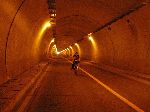
|
Each of the hills has a tunnel near
the top so you never climb fully to the top of the ridge. It is an
interesting kind of conditioning because later when there aren't tunnels to create
a short cut on the climb you get a little pissed off that the road builders are
making you go all the way to the pass. This tunnel is 2 kilometers long. Language lesson: The Korean word
for "tunnel" is "tunnel" spoken with a Korean accent. |
| |
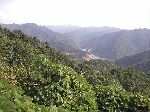
|
Bukhan River valley, the view outside
the first tunnel. It looks like a nice ride down into the valley. Of
course one of those hills in the distance is probably the next hill we'll be
climbing. |
| |
 |
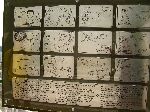 A new project
that was mostly complete in about 2006 is
the massive, high, Peace Dam. They have yet to start filling the
reservoir, but it is not exactly intended to be filled. The dam
is not far south of the DMZ, and should it fill the lake will extend into North
Korea. But the real back story is about a dams that North Koreans built
up-river on their side of the border. The south is concerned that in a
conflict the North might breach their dam in an effort to wash out bridges and
flood towns down to and including Seoul. This is conveyed to visitors in a
graphic poster. The dam sits and waits for its day to be a peace-maker. A new project
that was mostly complete in about 2006 is
the massive, high, Peace Dam. They have yet to start filling the
reservoir, but it is not exactly intended to be filled. The dam
is not far south of the DMZ, and should it fill the lake will extend into North
Korea. But the real back story is about a dams that North Koreans built
up-river on their side of the border. The south is concerned that in a
conflict the North might breach their dam in an effort to wash out bridges and
flood towns down to and including Seoul. This is conveyed to visitors in a
graphic poster. The dam sits and waits for its day to be a peace-maker. |
| |
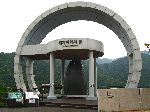
 |
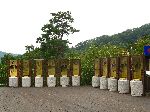 Peace
Dam is designed to be a tourist destinations as well with a World Peace Bell, an
exhibit of peace makers from around the world, visitors center,
museum, garden, pond, sculptures, murals, fountains, cafeteria and snack bar.
The landscaping is extensive, including along the top of the dam wall and around
the visitors center. Peace
Dam is designed to be a tourist destinations as well with a World Peace Bell, an
exhibit of peace makers from around the world, visitors center,
museum, garden, pond, sculptures, murals, fountains, cafeteria and snack bar.
The landscaping is extensive, including along the top of the dam wall and around
the visitors center.
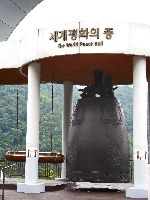 The
bell was made from empty cartridges from world's conflict zones) It is The
bell was made from empty cartridges from world's conflict zones) It is currently is unfinished and weighs 9,999 gwan. When peace is reached with the
North the last gwan (about 7.5 pounds) will be added.
currently is unfinished and weighs 9,999 gwan. When peace is reached with the
North the last gwan (about 7.5 pounds) will be added.
Unlike many of the other dams on the Han River, where they have
recently restricted driving across the top of the dam, the main road in this
area to the northeast now goes across the dam. |
| |
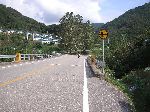
|
If you should be out driving you tank
down this road, note the sign that gives a weight limited for the bridge.
But it is not a trivial matter because this area is about 10 km from the
demilitarized zone. While perfectly tranquil at the moment, North Korea
and South Korea are still technically at war, and both sides have ten's of
thousands of troops stationed near the border. In additional to military
posts up most valleys, military vehicle are about half of the vehicles on these
otherwise the low volume on the
roads. There are also other indications that South Korea is still being
vitualent. |
| |
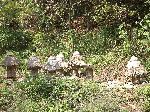
|
Traditional beehives -- a photo
dedicated to a frequent Ibike participant who is always interested in bee animal
husbandry in each country. For those who didn't know they were interested
in beehives, traditional beehives change a lot from region-to-region. |
| |
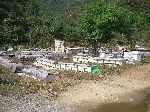
|
Modern beehives -- a photo dedicated
to a frequent Ibike participant who is always interested in bee animal husbandry
in each country. |
| |
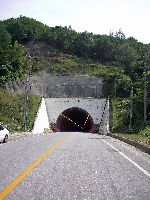
|
Yeah, another tunnel -- we must be at the
top of another hill and it is downhill on the other side! |
| |
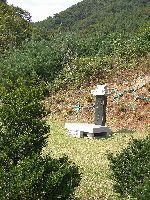
|
Buddhist grave high on the hill.
The flat stone is there for leaving offering (meals) for the deceased. |
| |
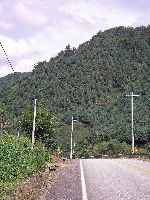
|
While clear cut forest were never
evident, there may have been more of it in the past. In fact, at the end of
the Korea War in the mid-1950's much of the countries forest were decimated and
mountainside erosion was a major problem. There was a concerted effort across
the country to reestablish and rehabilitate the forests. The straight lines,
uniformity and symmetry of this forest indicate that it was planted at the one
time. |
| |
 |
  The
valleys are primarily agricultures with a lot of variety. These three
consecutive picture show flowers in a green house, a field of sesame and millet
drying on a guard rail. The
valleys are primarily agricultures with a lot of variety. These three
consecutive picture show flowers in a green house, a field of sesame and millet
drying on a guard rail. |
| |
 |
 Historically,
like more than 600 years ago, and for 600 years to follow, Bangsan, has been a
center for royal white porcelain pottery. Today you can visit the Bangsan
Porcelain Museum and learn about the development of porcelain and production in
Yanggu, see fine ceramic pieces and see a replica of a traditional kiln (right). Historically,
like more than 600 years ago, and for 600 years to follow, Bangsan, has been a
center for royal white porcelain pottery. Today you can visit the Bangsan
Porcelain Museum and learn about the development of porcelain and production in
Yanggu, see fine ceramic pieces and see a replica of a traditional kiln (right). |
| |
 |
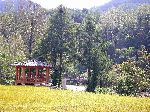 Jikyeon Falls
and pavilion, Bangsan. The country
is dotted with pavilions next to waterfalls, along rivers, on hill tops and
under large trees. It is a message to me that people enjoy relaxing. Jikyeon Falls
and pavilion, Bangsan. The country
is dotted with pavilions next to waterfalls, along rivers, on hill tops and
under large trees. It is a message to me that people enjoy relaxing. |
| |
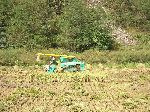
|
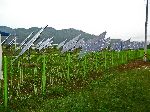 Rice harvesting combine
(left). This
machine cuts, separates and bags the rice, while leaving the straw in the field.
Few farmers own their own rice harvester, but can arrange for the use of one
from the agricultural coop, one of the biggest business entities in rural South
Korea. Rice harvesting combine
(left). This
machine cuts, separates and bags the rice, while leaving the straw in the field.
Few farmers own their own rice harvester, but can arrange for the use of one
from the agricultural coop, one of the biggest business entities in rural South
Korea.A new feature in one farm field was an array of solar voltaic panels
(right). |
| |
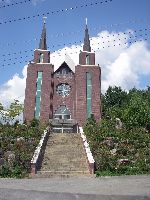 |
It seems to be generally accepted
that 30% of South Koreans are Christians, 30% are Buddhist and the other 40% are
unaffiliated. Overlaying all of this is a Confucius philosophy and touches
of traditional shamanism. |
| |
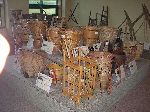
|
Pallang-ri folk museum
(right). Displays
include baskets, furniture, back packs and musical instruments.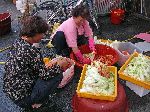 Two women preparing kimchi.
Kimchi comes in dozens of varieties. It is a way to keep vegetables for a
long time, while preserving there nutrient quality. Koreans claim that it
helps retard dozens of ills, including diabetes and some kinds of cancer (see
http://www.treelight.com/health/KimchiHealthy.html |
| |
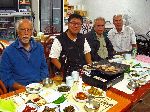 |
On one visit the
chairperson of the local council greeted us on the road near the edge of Pallang |
| |
|
|
| |
Hwacheon

 Wontong Wontong |
|
    |
 |
|
|
 Please
contact us if you would like to be added to
Ibike's mailing list or have questions, comments, corrections or criticism. (Also, please let us know how you learned about us and
found this site.) Privacy policy. Please
contact us if you would like to be added to
Ibike's mailing list or have questions, comments, corrections or criticism. (Also, please let us know how you learned about us and
found this site.) Privacy policy.
 IBF Homepage
IBF Homepage  Ibike Programs
Ibike Programs
 Ibike Schedule
Ibike Schedule
 Search
Search
"Hosted by
DreamHost - earth friendly web hosting"
Created by David Mozer
Copyright ?1993-2018 Ibike LLC. All rights reserved.
|
 Photo essay: Hwacheon
to Pallang-ri
Photo essay: Hwacheon
to Pallang-ri







 A major feature of the day is climb
ridges and descending down the other side. They aren't steep but they take
perseverance. They curve so much that you can really tell how high you
climb. It is probably just as well because if you could see the top from
the bottom you would probably be totally demoralized.
A major feature of the day is climb
ridges and descending down the other side. They aren't steep but they take
perseverance. They curve so much that you can really tell how high you
climb. It is probably just as well because if you could see the top from
the bottom you would probably be totally demoralized. 



 A new project
that was mostly complete in about 2006 is
the massive, high, Peace Dam. They have yet to start filling the
reservoir, but it is not exactly intended to be filled. The dam
is not far south of the DMZ, and should it fill the lake will extend into North
Korea. But the real back story is about a dams that North Koreans built
up-river on their side of the border. The south is concerned that in a
conflict the North might breach their dam in an effort to wash out bridges and
flood towns down to and including Seoul. This is conveyed to visitors in a
graphic poster. The dam sits and waits for its day to be a peace-maker.
A new project
that was mostly complete in about 2006 is
the massive, high, Peace Dam. They have yet to start filling the
reservoir, but it is not exactly intended to be filled. The dam
is not far south of the DMZ, and should it fill the lake will extend into North
Korea. But the real back story is about a dams that North Koreans built
up-river on their side of the border. The south is concerned that in a
conflict the North might breach their dam in an effort to wash out bridges and
flood towns down to and including Seoul. This is conveyed to visitors in a
graphic poster. The dam sits and waits for its day to be a peace-maker.

 Peace
Dam is designed to be a tourist destinations as well with a World Peace Bell, an
exhibit of peace makers from around the world, visitors center,
museum, garden, pond, sculptures, murals, fountains, cafeteria and snack bar.
The landscaping is extensive, including along the top of the dam wall and around
the visitors center.
Peace
Dam is designed to be a tourist destinations as well with a World Peace Bell, an
exhibit of peace makers from around the world, visitors center,
museum, garden, pond, sculptures, murals, fountains, cafeteria and snack bar.
The landscaping is extensive, including along the top of the dam wall and around
the visitors center. The
bell was made from empty cartridges from world's conflict zones) It is
The
bell was made from empty cartridges from world's conflict zones) It is








 The
valleys are primarily agricultures with a lot of variety. These three
consecutive picture show flowers in a green house, a field of sesame and millet
drying on a guard rail.
The
valleys are primarily agricultures with a lot of variety. These three
consecutive picture show flowers in a green house, a field of sesame and millet
drying on a guard rail.
 Historically,
like more than 600 years ago, and for 600 years to follow, Bangsan, has been a
center for royal white porcelain pottery. Today you can visit the Bangsan
Porcelain Museum and learn about the development of porcelain and production in
Yanggu, see fine ceramic pieces and see a replica of a traditional kiln (right).
Historically,
like more than 600 years ago, and for 600 years to follow, Bangsan, has been a
center for royal white porcelain pottery. Today you can visit the Bangsan
Porcelain Museum and learn about the development of porcelain and production in
Yanggu, see fine ceramic pieces and see a replica of a traditional kiln (right).
 Jikyeon Falls
and pavilion, Bangsan. The country
is dotted with pavilions next to waterfalls, along rivers, on hill tops and
under large trees. It is a message to me that people enjoy relaxing.
Jikyeon Falls
and pavilion, Bangsan. The country
is dotted with pavilions next to waterfalls, along rivers, on hill tops and
under large trees. It is a message to me that people enjoy relaxing.
 Rice harvesting combine
(left). This
machine cuts, separates and bags the rice, while leaving the straw in the field.
Few farmers own their own rice harvester, but can arrange for the use of one
from the agricultural coop, one of the biggest business entities in rural South
Korea.
Rice harvesting combine
(left). This
machine cuts, separates and bags the rice, while leaving the straw in the field.
Few farmers own their own rice harvester, but can arrange for the use of one
from the agricultural coop, one of the biggest business entities in rural South
Korea.



 Please
contact us if you would like to be added to
Ibike's mailing list or have questions, comments, corrections or criticism. (Also, please let us know how you learned about us and
found this site.) Privacy policy.
Please
contact us if you would like to be added to
Ibike's mailing list or have questions, comments, corrections or criticism. (Also, please let us know how you learned about us and
found this site.) Privacy policy.![]() IBF Homepage
IBF Homepage ![]() Ibike Programs
Ibike Programs
![]() Ibike Schedule
Ibike Schedule
![]() Search
Search


